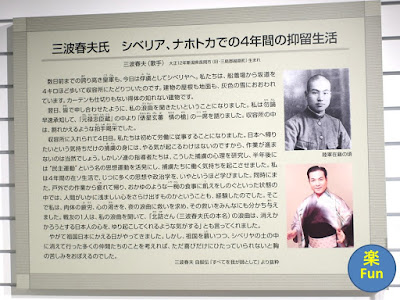Japanese soldiers who were detained and worked in Siberia created fun even under the difficult condition. They made boardgame by themselves and enjoyed music. Those helped them to live.
However, I regret that I cannot see the difficulties of Asian people who were invaded by Japan here.
第二次世界大戦における日本人の労苦を展示した資料館(総務省委託)である。戦争の記録だが、その中にも楽しみがないか、敢えて訪ねた。
いつ帰れるとも分からない、また、寒さで同僚が死んでいくシベリア抑留のなかでも、楽しみとして、自分たちで作った麻雀パイ、将棋の駒が展示されていた。私の心を打ったのは、三波春夫の浪曲。歌があれば、楽しむのは無理としても、命はつないで行けそうだ。
日本人が苦労した、苦しんだ証拠が展示されていたが、日本の侵略によって苦しんだアジアの方々の展示がないのが残念。英文名称そのままの展示館だ。日本人から見た、兵士、シベリア抑留者、引き揚げ者の悲劇について展示されている。Detainees in Siberia、シベリア抑留の展示コーナー
In the very cold place, detainees built roads and lands. Unfortunately, many people died.
極寒の地での森林開拓、道路建設などの強制労働は、大変な苦難で多くの人の死を招いた。
The theme of this showcase is “Sustaining Morale with Simple Pleasures “. There are pieces of shougi (Japanese chess) and mahjong which were made by detainees, song lyrics sheets, notebooks in which a lady was described and so on.
抑留の中の楽しみのコーナーがあった。将棋の駒や、麻雀パイを作った。歌詞カードがあったり、女性の絵を描いたノートもあった。
Handmade shogi (chess) pieces、自作の将棋の駒と袋
Handmade mahjong tiles; It seems to be easy
to know what tiles players had.
自作の麻雀パイ。何のパイかすぐに分かりそうだ。
A lady on the supplied notebook、手帳に書いた女性の絵
Handmade booklet of popular songs
歌謡曲集(鳥取県・松本都氏)
The panel bellow shows the activity of the famous singer “Haruo Minami”. His Roukyoku songs entertained detainees even in extreme situations. Songs makes people to be happy and give the hope to live.
その中では、歌。三波春夫のパネルがあり、浪曲で皆を楽しませた。極限状態でも、歌は人を明るくする、楽しませる。生きたいと思わせる。
Letters also gave people the hope to live. How the correspondence with family members supported detainees. 453,850 people could return and meet their family. How happy they were. The final ship arrived at Japan in 1956 which was 11 years later of the WWⅡ.
さらに、生きたいと思わせるのは、家族とのやり取りの手紙。どれだけ、抑留兵を支えたことか。そして、再会した家族。うれしかったと思う。最後の船が帰ってきたのは、戦後11年がたった1956年であった。453,850人が帰国している。
Postwar Repatriates、引き揚げ者のコーナー
Ms. Hirota escaped from Chine with her daughter and baby. She was detained in Korea for one year, and she lost her baby then.When she departed for Japan, she would like to dress her daughter so she made clothes bellow for her which was made from baby’s diapers.
The war robs fun and happiness from ordinary people.
おむつで作った子供用ワンピース
満州から釜山を目指して、娘と赤ん坊とともに引き揚げていた滋賀県出身の女性・広田きみ氏は、朝鮮北部で一年間の収容所生活を余儀なくされ、赤ん坊を栄養失調で赤ん坊を無くした。釜山港に到着し、日本に引き揚げる時に、せめて綺麗な服を着せてあげようと思い、亡くなった赤ん坊の布おむつでワンピースを作ったという。泣ける話である。
I knew lots of difficulties of Japanese people, however, I couldn’t know the difficulties of Asian people who were in the battle fields. I regretted it very much.
日本人の苦しみが展示されていたが、日本が戦場にしてしまったアジアに住んでいた人たちの苦しみの展示がなかったのが、極めて残念である。
Entrance、資料館入り口
The museum is at the 33rd floor
of Shinjuku Sumitomo Building
Six funs(楽fun)were found. Visited in August, 2019
Website: https://www.heiwakinen.go.jp/english-index/ (in English)
https://www.heiwakinen.go.jp/ (much information in Japanese language site), accessed in May, 2020
Previous post (Museum in Shinjuku):
Next post (Museum near Shijuku):
The Museum of Toshima City 豊島区立郷土資料館












Comments
Post a Comment